Roundwood - The Development of North Harpenden
Jesse Catton and the Roundwood district - 1920s to 1960s
John Wyborn spent his childhood and adolescence at 10 Roundwood Park. His description of the road and its inhabitants has been illustrated by photos taken in 2018 of those houses which have survived – a few unaltered and most modified. Towards the northern end many have been demolished. If there are surviving photos of the original houses, built in the 1920s and 1930s, we would appreciate copies for the local history archives. ed
Catton Houses
Harpenden at the End of World War I was a small village, with very little development north of the Nickey Railway Bridge. A Sale Map of building land dated July 1920 shows open fields north of the ‘Nickey’ save for some Victorian houses along the main road and into Harpenden Rise, and the small terrace houses at the bottom of Park Hill. Jesse Catton is shown as the owner of land adjacent to Roundwood Lane, and the small area marked as ‘Round Wood’ in the middle of farmland was a picturesque bluebell wood, shortly to give its name to the whole district.
Jesse Catton seized the opportunity for development. Post war activity saw Luton develop from a small hat-making town to a centre of modern manufacturing, with Vauxhall Motors, the Commer Works, Skefco Ball Bearings and many other plants ensuring an influx of skilled workers to the district as well as executives looking for somewhere to live, not necessarily in the ‘smoke’. Steam express trains could reach St Pancras in about 45 minutes with one or two stops. City workers could reach Moorgate within the hour if they didn’t mind a long smoky tunnel near Kings Cross, only partly ameliorated by a condenser attached to the steam engine.
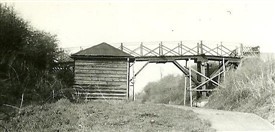
Jesse Catton’s rustic-style bridge at Roundwood Halt – c.1948
The Nickey train had been diverted from a link to Luton into a link with Harpenden on 2 July 1888. By 1927 there was enough traffic from Roundwood to justify the building of Roundwood Halt, which opened on 8 August 1927 with trains connecting with the London Expresses. Catton arranged with the Midland Railway to erect a footbridge in 1926, which lasted until the late 1940s. This provided a footpath link with both sides of the railway and Catton chose a rustic timber-built design in keeping with a determination that Harpenden should remain unspoilt and countrified. People said it reminded them of an alpine village scene.
Catton houses were well designed by contemporary standards, but were built down to a price. Not attempting the top end of the market, already dominated by the Jarvis brothers, they were serviceable but lacking the ‘Jarvis’ finish. Jesse Catton once told my father that he regarded himself as ‘the Jerry Builder of Harpenden’. After World War II when Jarvis houses in West Common were selling for £8-9,000, a Catton house might fetch £4-5,000 – albeit large sums in those days. And – unheard of today – quite a few of them could be rented: you did not have to buy.
A Rural Atmosphere
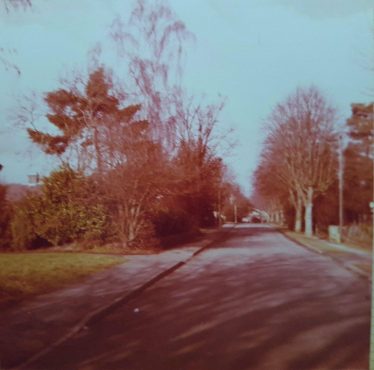
Roundwood Park in the 1970s – still an informal streetscape
A feature of Catton estates was the preservation of the rural atmosphere. Quite a few streets were ‘private roads’. This meant that there was no tarmac. Gravel roadways were laid in Townsend Lane, the whole of Moreton End Lane, Roundwood Park, Park Rise and Wood End Road, as well as Bloomfield Road (but not Hillside Road). Although not much fun for the motorist, these roads carried an air of refinement. Only gentlefolk lived in private roads. The streets belonged to the residents, who would stretch a piece of rope across the entrance, usually once a year at Christmas or a bank holiday, to preserve the fact that you entered by permission and not by right.
The Roundwood Estate
Roundwood Park never tried to be symmetrical. People had a horror of being neat and ‘suburban’. There was a roadway in the middle full of puddles and potholes. Footpaths found their way down each side, separated by uneven grass verges which would wander from side to side in places to avoid pre-existent trees and tree stumps. Bluebells and other wild flowers would grow, and no one thought it necessary to crop them or to straighten the kinks. Cats and dogs ran free to make the most of lamp posts and tree stumps. If you didn’t like it you just watched where you trod. Most of the animals would sit calmly by the owners’ front gates. I knew many of them by name. I would talk to them and they would wag their tails as you passed.
Roundwood and Wood End estates were aimed at the junior or middle executive and professional market. Apart from a few bungalows it was assumed that you would have a front door for guests, and a tradesmen’s entrance around the side for everybody else. A live-in maid or domestic servant was presumed.
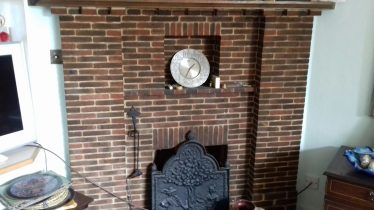
Bell push beside 1935 Jarvis fireplace, Bloomfield Road
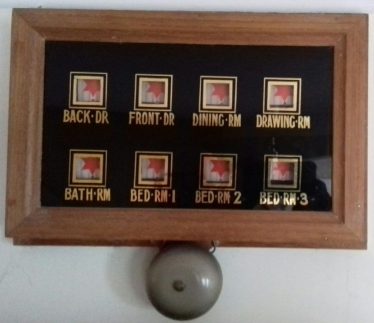
1935 bell system – main board at 45 Bloomfield Road, then home of Managing Director of Vauxhalls. Sir Reginald Pearson
Most new homes would be fitted with a doorbell system and a maid-call unit in the kitchen, which was where the maid lived. There would be bell pushes at front door, back door, both reception rooms, bathroom and the main bedrooms. The maid would be expected answer the bell in accordance with the call indicator – a delight for small boys who would run round making them all ring at once.
Another feature of a private road was that the houses all had names and not numbers. If you bought your house you could name it yourself. If not Mr Catton would name it. Ours was built in state-of-the-art art-deco style with bright green roof tiles, and he called it ‘Green-Top’. It was the end house in the spring of 1938 when none of the others had been completed. In the following year we were told to use numbers. I remember seeing my father hammering the number 10 on to our front gate post
The People of Roundwood
So who were these people who moved into Roundwood in those days? Many are preserved by name in the Kelly Street Directories. 1938 reveals how many there were. In Roundwood Lane at No 2 lived Mr and Mrs Day, a young couple who would wave to me when at age five I was allowed to see my father off to Luton on the 321 bus at the Old Bell, using the field path which still exists. At Woodlands lived the Wrights, mentioned elsewhere. At ‘Brierfield’ next to Titmusses Farm lived Alec Shanks the Impresario. A celebrated resident who lived in Wood End Road was George Ross-Goobey. I remember him mainly as a tall man with fair hair and a funny name. After World War II he became well-known in the City for introducing ‘the cult of the equity’ whereby pension schemes and trusts invested in ordinary shares as well as gilts. With the long post-war bull market this greatly influenced our future finances.
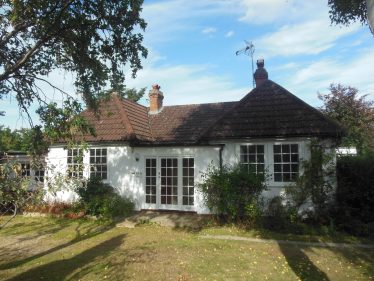
Roundwood Crest, nos. 54 & 54a, built by 1926, has been occupied by the same family since 1960.
At ‘Ayot’ in Roundwood Park (site of 52, demolished in the early 1970s) lived Frank Moore who kept a large poultry farm on the borders of Roundwood Lane. With a gammy leg from the trenches of World War I he was the only person I ever remember hearing my father talk with about the battlefields of Flanders. He shared a house with a single lady, Miss Foxlee. A keen darts player, Frank Moore was a regular in the saloon bar of the Old Bell, where he was known as ‘Dartmoor’.
Further up the road (at site of no, 46) was Dr Hester who became celebrated over the years as one of Harpenden’s most popular GPs. They had a son and a daughter, later moving to a larger house in Milton Road. This was a wise move. To everyone delight and surprise, Mrs Hester later produced triplets.
The Johnsons at ‘Cranhurst’ (site of no.50, demolished in the early 1970s) had a daughter and a son whom I knew at Moreton End School. He had diabetes and his mother used to inject him several time a day. Very sadly he died in a diabetic coma when abroad in his teens.
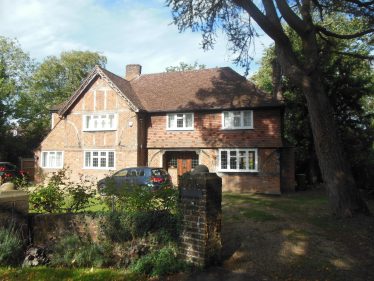
‘The Belt’, now 30 Roundwood Park, former home of the Maslin family
At ‘The Belt’ (no.30) lived the Maslins who had a boy called Roger whom I knew. Once we were invited to his granny’s for tea. Roger’s grandparents were Sir George and Lady Beharrell who lived in great style at ‘Barnards’ Oakhurst Avenue. Sir George, as chairman of Dunlop Rubber, was one of the real national bigwigs of the day, which showed what Roundwood could (almost) do for you socially.
The Round Wood
The next houses, Beech Grove (28) and Hawkswick (26), as well as Cherry Trees (21) and The Coppice (23) opposite, were sited in the middle of the original Round Wood and had heavily wooded gardens and architecture of a higher standard.
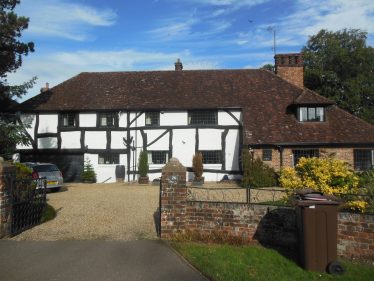
Hawkswick, built c.1935/6
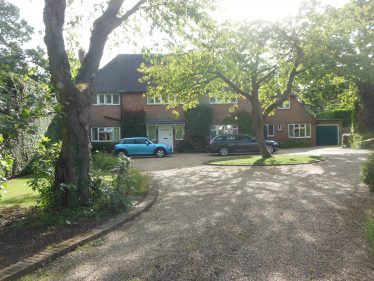
Cherry Trees , no.21 Roundwood Park
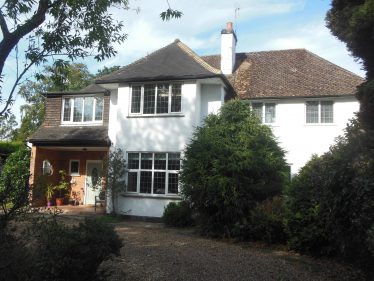
Woodlands Corner, no.22, was on a very large plot
At Woodlands Corner (no. 22) lived Cecil and Dolly Mayall, Dolly becoming a very special friend of my mother’s. Cecil had held a senior post in the Sudan, with Dolly being the Provincial Governor’s Lady. She was sweet. She never referred to her earlier life as the Queen’s Representative, though friends may have noticed she kept one pet dog. It was always a corgi. She drove a large Morris 18HP saloon, which she called ‘Stanley Baldwin’. When you could get petrol, Dolly would park ‘Stanley Baldwin’ unlocked in the triangle near Lloyds Bank on shopping days. If you knew her you had an open invitation to put your shopping in her boot and get driven up the hill. She was one of those people who would greet each day in a spirit of high-hearted happiness, and she had many friends.
Other neighbours included a senior Vauxhall Manager, several hat manufacturers with businesses in Luton, Wyvil Baldwin a Special Commissioner of Income Tax, some bank managers, and Dr Colin Butler, a Rothamsted Bee Specialist.
The Shadow of War
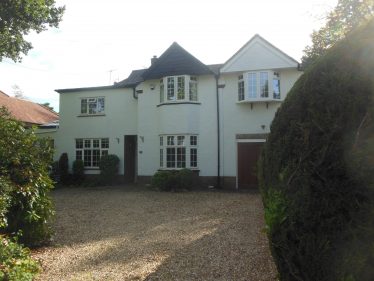
‘Lindley’ no.19 Roundwood Park
The war was not kind to everyone. Herbert and Muriel Stocken lived at ‘Lindley’ (19) next to the footpath. Herbert was a stock-jobber on the London Market. They had two children, Geoffrey and Margery. Geoffrey joined the RAF at the beginning of the war. He got shot down and killed. A year or two later Margery joined the Wrens. Engaged in secret war work involving little understood radiation, she contracted leukaemia, about which very little was known. I recall seeing her driven off in an ambulance. To save the family extra distress Dolly – their sister in law, would post written bulletins on the front gate which I would be sent to read ‘There is no great change in Margery’s condition…’ it would begin. Eventually she died. A war grave for both of the young Stockens can be seen in Westfield Cemetery. I felt a special link with Geoffrey, whom I never knew, because his mother passed to me all his Hornby trains. I spent many hours with friends at a time when such toys were unobtainable even if you had the money.
At Cherry Trees the Veale family also lost a son who has a war grave in the cemetery with his fellow crew member.
Billeting in War-time
An important resident at ‘Merrilees’ (43, demolished) was Mrs Stretton who acted as Billeting Officer for the road. If you had a spare bedroom you had to declare it and she would fill it with refugees. Realising my mother was unfit – she had bronchiectasis which was a serious condition before antibiotics, Mrs Stretton advised ‘Get an Officer – they’re less trouble! ‘ So we did. Milk was rationed but we had a sensible land girl who delivered our milk and who decided that my mother needed an extra pint. People used their common-sense – there were few ‘jobsworths’ in Roundwood.
A stalwart resident was Constance Fleming, a redoubtable Irish lady who lived alone in a little bungalow called Ardnagreana (41, demolished). Fiercely independent, Constance had some kind of progressing nerve complaint and was gradually losing all her faculties. By the beginning of World War II she was totally deaf. Ben Jarman, the captain of the Bell Ringers took her into the bell loft at St Nicholas Church; she could just hear the church bells. Alone in her cottage with two callipers to support her failing legs she would not contemplate going into care. In her porch was a notepad and a pencil for callers to explain what they wanted. She would try and lip read but it didn’t always work. Her door bell was specially adapted. In the daytime it flashed the house lights on when you pressed it, at night it turned them off… Constance was always cheerful with a funny story to tell and a twinkle. She was greatly supported by Dolly Mayall and it was a heavy blow to her when Dolly died.
A notable Catton resident was the then Chairman of Vauxhall Motors. Sir Charles Bartlett was unusual for those days. He had risen to the top in his company having started on the shop floor. He had a great following among the work force, and prided himself on never having a strike. If there was a problem ‘Skipper’ would go on to the shop floor and fix it with the lads. Vauxhall became one of the best places in which to work. ‘Skipper’ lived during the War with a group of fellow Vauxhall production executives at the top of Bloomfield Road. His chauffeur, Charlie Thornett, lived at 23 Park Hill and was to be seen carefully polishing a shiny Vauxhall 25 HP limousine. Later Sir Charles moved to Whitewalls in Kinsbourne Green, when the Army vacated it.
A Benevolent Landlord
Jesse Catton provided the initiative that brought all these people together. A perceptive man he clearly realised that not everyone could be successful in life. He had a regard for his tenants. Each Christmas he would send a gift, usually a chicken for the table, with the Landlord’s compliments. This became an annual event upon which we came to rely. On Christmas Eve 1944 we had a full house of guests. A ring at the door. ‘Mr Catton’s compliments but he’s run short of chickens and he hopes you’ll enjoy this sack of potatoes instead’. Panic. My father was dispatched post-haste to the Village, returning in due course with what was probably the last turkey in Harpenden – and also the oldest!
These are now far off days, and they reflect a kind of neighbourliness that, with modern life, we are unlikely to see again. But it may give an idea of what politicians call ‘British Values’ as they once were.
This Happy Breed – the Social Structure
Those days were not good for all. Noel Coward’s film ‘This Happy Breed’ paints a realistic picture of what life was really like for most people. In this present age of ‘required Equality and Inclusivity’ it is not easy to present a balanced and understandable picture of life in the 1930’s and early 1940’s. People were positive and reasonable on the whole and they pulled together. Yet it was the considered wisdom of the day that everyone knew their place in society and accepted it. We were proud of the British Empire which was seen as a very good thing since it (usually) ensured peace in the world.
Women had got the vote (not all that long after men had been given it). Yet a man would expect his wife to stop working when she married, and teachers were actually required to. Society considered you were not much of a man if you couldn’t support your wife and children. It was a matter of self-respect. There was no National Health Service. You paid to see your doctor who would call at the house. If you could not afford this, you would be enlisted as a ‘panel patient’. You would queue at the surgery and see whichever doctor was free. Likewise in hospital you would be a private patient with your own room and you would pay. Otherwise you’d be in a public ward, under the care of a specialist known as an Honorary Consultant. He would peer down upon you from a great height, surrounded by his students. He was ‘giving’ his services in support of the poor and needy. Everyone would call him ‘sir’.
In education there was a gulf between the private and the public. State education in the so-called ‘council schools’ ended at age fourteen. No examinations were taken and you had no qualifications. If you were a girl you might go into domestic service; if a boy into a factory as a trainee operator. Only private school pupils took the School Certificates – pre-runners of the ‘O’ levels – for which your private school would enter you. Private school children had very little contact with state school children, except possibly through the churches. You dressed differently, spoke differently, played differently, used different slang and probably lived in different Harpenden streets. They played in the road; we played in our homes or gardens, and possibly in the fields. One Harpenden Sunday School only admitted private pupils. All of this was considered normal.
On the other hand there was no racial discrimination. You seldom met anyone who was not English, Welsh, Scottish or Irish, or perhaps a Jewish refugee. People were horrified when the racially segregated American troops arrived, later in the war. We felt an affinity with the overseas nations of our own British Empire, even though we never met or understood them.
World War II brought an immediate and swift change to a lot of it, but much remained to be done at the end of the war. It partly explains why Churchill’s Conservative Party was so heavily defeated in 1945. People had had enough. The country was bankrupt and we had little food. But in a few short years we had a National Health Service, the School Leaving Age was raised, O and A Levels were made available to all, university education was widened, and the country began the long, slow recovery that ultimately led the Prime Minister of the day to say ‘You Never Had It so Good!’. The 1960’s, though far short of 21st Century standards, became misleadingly known as ‘the Affluent Society’.
The 1939 Census
When war was declared the most up-to-date National Census was nearly ten years old. On 29th August 1939 a new Census was quickly carried out and later used to issue ration books and identity cards. It is now in the public domain, with subsequent changes of name on marriage being added by hand. It shows that we had a young teenager called Joan living with us. Most domestic servants were expected to be demure and respectful. Joan was none of those things, nor did my mother expect her to be. Irrepressibly cheerful I have memories of hearing her doing my mother’s housework and singing at the top of her voice ‘With a Song in my Heart!’
Fifty years later an elderly lady approached me at my mother’s funeral. ‘I wonder if you remember me. I am Joan.’ We spoke briefly and I thanked her for coming. ‘Oh, I wasn’t going to miss this.’ she exclaimed. And we laughed!
Postscript
Prompted by photos of the surviving houses, John has added information about the families of his immediate neighbours with whom he grew up with during the 1940s and 1950s – these have been moved to a new page :

Comments about this page
My sister was born at our grandparents house at 12 Roundwood Park (Reg and Gladys Baker). We believe they inherited the house name of Kokanag (might not be the correct spelling) from the previous owners who resided in India. Does anyone have a photo of the sign – Kokanag – which was hung at the front of the house? A long shot, I know. We are trying to compile a memory book for our Mum who lived at number 12 during her childhood.
Donna: I am pleased you remembered no 12. Our next door neighbours Ted and Cath Harmer lived there during WW2. They had lived in India during the Raj and tended to look down on the Colonial races which was normal. He was a keen golfer and they would hold singing evenings and he would sing ‘The Road to Mandalay’. At the 50th anniversary of VE DAY a young doctor and his wife were there and offered us champagne. Any relation?
I was born at 12 Roundwood Park.
Ed. Has the house changed since you lived there?
Service at Roundwood Halt was ‘temporarily suspended’ on 16 June 1947 and never re-instated. There was some debate as to whether or not the consequent closure of Roundwood Halt was legal, since there was no proper notification of intended closure. It just happened by default and there does not seem to be any record of protest by the residents of Roundwood Park.
At the same time Harpenden Urban District Council took over Catton’s wooden bridge, which they replaced with a steel structure at the end of September 1951. This was dismantled when the Nickey Line track was ripped up in 1983 and converted to a cycle-way and footpath.
Add a comment about this page